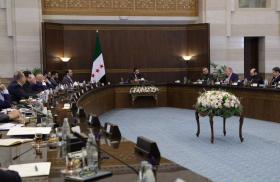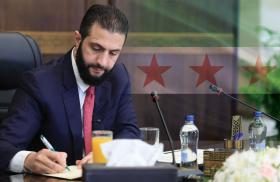
- Policy Analysis
- PolicyWatch 4118
Four Keys for Iran Snapback Implementation

Inevitable attempts by Tehran to rebuild its nuclear and missile programs will require a U.S.-led campaign to track the regime’s proliferation activities and block transfers of related materials.
At midnight after September 27, United Nations sanctions against Iran snapped back into place, rendering officially moot the Joint Comprehensive Plan of Action—the 2015 nuclear deal—and turning the page on what could have been a vital nonproliferation agreement. Yet the story of Iran’s nuclear and missile programs is nowhere near finished. Open-source imagery and analysis show that Iran continues to work on its nuclear program, including expanding the tunnels already begun south of the main Natanz site, and to reconstitute its missile program.
Iran may already possess most of the materials and components for these programs. After all, the programs have existed for decades, and Iran understood the risks of being attacked long before the Israeli military action in June 2025. But the Islamic Republic very likely will need to source from abroad some of the materials and equipment for its nuclear and missile programs.
This is where snapback comes in. Although the resumption of UN Security Council sanctions—and accordingly those from the European Union and individual countries—may exert limited additional economic pressure, which will be compounded by the political consequences of once more being under UN sanctions, the most important practical consequence of snapback will be in combating Iranian proliferation. Contained within Security Council Resolutions 1737, 1747, 1803, and 1929 are powerful authorities that states can use to prevent Iranian proliferation activity. But to fulfill their mandatory legal obligations, states will need help to achieve implementation.
Acknowledge the Likelihood of Iranian Reconstitution Efforts
Although the June military campaign badly damaged Iran’s capabilities, it did not obliterate the regime’s nuclear or missile program. Iran retains important elements of both, including high-enriched uranium and missiles, along with the experience of many top scientists and technicians. The country will not need to start over from scratch, and its likely efforts to source components and materials from abroad will supplement and support—rather than entirely reestablish—existing programs. Effective collaboration in addressing Iranian proliferation activities will therefore require that countries acknowledge these realities, and take seriously reports of Iranian proliferation activity.
Maintain Intelligence Collection and Perform Chokepoint Analysis
Amid likely Iranian attempts to reconstitute its programs, intelligence collection on its proliferation activities should remain a priority for the United States and its partners. Israel will almost certainly continue to prioritize Iranian proliferation, but other countries—either lacking the resources or concentration—may not do the same.
For this reason, the United States should conduct a thorough analysis aimed at identifying Iran’s likely high-priority procurement requirements. In the past, internal U.S. analysis flagged particular materials or items urgently needed by Iran, using them as focal points for international engagement. For example, in the late 2000s, the United States concluded that carbon fiber would be one such high priority requirement, and provided partners with substantial information about this material to help them implement their UN obligations. More specifically, carbon fiber was identified as being sufficiently hard to source and important to Iran’s uranium enrichment program that preventing its acquisition would serve as a “chokepoint” for the whole program. In the end, the United States could not prevent Iran from acquiring carbon fiber altogether, but its actions probably delayed the program and made the process harder and more costly. This counts as a nonproliferation win because interference can buy time and space for diplomacy or even further military action if necessary.
Engage in Intelligence Sharing and Collaboration
When countries detect information concerning Iranian proliferation, it needs to be acted on. This includes both immediate intelligence detecting a specific procurement, and general trends such as would be revealed through a chokepoint analysis. In an ideal world, the United States would work closely with its European partners to brief other foreign governments on its broad analysis, as well as provide specific information allowing for interdiction of shipments or cancellation of deals. This work would be facilitated by a close, expert-level coordination cell that discusses intelligence on proliferation cases, assigns priority to the information, and parcels out diplomatic engagement to the governments best suited for outreach. Such an effort could build on a diplomatic campaign from 2007–12, when the United States worked with like-minded countries in Europe, East Asia, and the Middle East to assign responsibility for managing particular cases and collaboratively prevent transfers.
This arrangement also allowed governments to voluntarily work with others outside the group with whom they had strong relationships—e.g., at the time, the United States and Iraq—or to defer to others if the relationships were weak. For example, given current trade-related tensions, the United States probably would find it difficult to work with India on proliferation cases involving Iran; European governments may be more successful and could be authorized to present U.S.-derived information to India that otherwise might not be well-received.
Such a group could also serve as a surrogate for the UN, given the Russian and Chinese position that snapback of UN sanctions was inappropriate and—as a matter of policy—legally illegitimate. This perspective will prevent the creation and effective functioning of the UN sanctions committee and panel of experts designed to help UN member states understand their obligations and authorities. The group of like-minded countries, moreover, could gather information from open sources about Iranian proliferation activity and produce public reports about trends in Iranian procurement.
Refresh Awareness of UNSCR Contents
Another important part of the snapback story involves the likelihood that countries have forgotten the details of the various Security Council sanctions resolutions, the first of which was adopted almost nineteen years ago. When aggregated, the resolutions contain significant requirements and authorities, as summarized here:
- A legally binding requirement that states take steps to prevent Iran from acquiring both specified nuclear and missile technology, as well as any items if a state concluded they would assist Iran with proliferation-sensitive nuclear activities or development of nuclear weapon delivery systems.
- A legally binding requirement that states “take the necessary measures to prevent the provision to Iran” of a long list of services that could support its nuclear or missile program.
- A legally binding requirement that states freeze the assets and prevent the travel of a long list of entities and individuals.
- A legally binding prohibition on states providing Iran with a long list of conventional arms or the services necessary to support them.
- Legally binding prohibitions on Iranian arms sales, nuclear or missile transfers, and a variety of nuclear activities.
- Authorization for states to inspect Iranian ships and aircraft suspected of being engaged in proliferation, to deny financial and other services if suspected of contributing to proliferation, and to prevent Iran from operating in their territories in various ways if the states involved suspect illicit conduct.
Other authorities might also be of particular importance to individual countries, but they all notably either require action by UN member states or grant these states permission to act to protect themselves and their interests. Furthermore, while states must adhere to Security Council requirements, the resolutions are open to interpretation if steps are deemed necessary to prevent proliferation. A number of UN members—not least the EU, Japan, and South Korea—used this premise to block Iran from oil- and gas-related trade in 2010.
The United States and its partners should look carefully at the UN Security Council resolutions and identify similar ways to harness their measures toward preventing Iran from reconstituting its nuclear and missile programs. Only in doing so can these actors ensure that snapback contributes to delaying Iran’s programs and conclusively resolving international concerns about the regime’s nuclear and missile ambitions.
Richard Nephew is the Bernstein Adjunct Fellow at The Washington Institute and former U.S. deputy special envoy for Iran.



